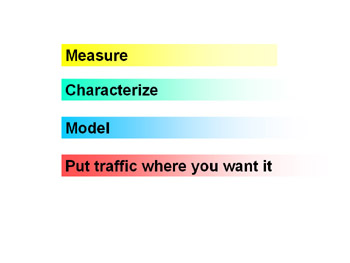Rick Gallahers MPLS Training Guide: Building Multi Protocol Label Switching Networks
|
| < Day Day Up > |
|
In data and voice networks, traffic engineering functions in order to direct traffic to the available resources. If achieving a smooth-flowing network by moving traffic around were a simple process, our networks would never experience slowdowns or rush hours.
On the Internet (as with highways), four steps must be undertaken to achieve traffic engineering: measuring, characterizing, modeling, and moving traffic to its desired location (see Figure 5.2).

-
Measuring traffic is a process of collecting network metrics, such as the number of packets, the size of packets, packets traveling during the peak busy hour, traffic trends, applications most used, and performance data (i.e., downloading and processing speeds).
-
Characterizing traffic is a process that breaks raw data into different categories so that it can be statistically modeled. Here, the data that is gathered in the measurement stage is sorted and categorized.
-
Modeling traffic is a process of using all the traffic characteristics and the statistically analyzed traffic to derive repeatable formulas and algorithms from the data. When traffic has been mathematically modeled, different scenarios can be run against the traffic patterns-for instance, 'What happens if voice/streaming traffic grows 2 percent per month for four months?' Once traffic is correctly modeled, simulation software can be used to look at traffic under differing conditions.
-
Putting traffic where you want it is an essential component of traffic engineering. To measure, characterize, and model traffic for the entire Internet is an immense task that would require resources far in excess of those at our disposal. Before MPLS was implemented, engineers had to understand the characteristics and the traffic models of the entire Internet in order to perform traffic engineering.
Articles and white papers tend to focus on only one aspect of MPLS traffic engineering. For example, you may read an article about traffic engineering that addresses only signaling protocols or one that just talks about modeling; however, in order to perform true traffic engineering, all four aspects must be thoroughly considered.
With the advent of MPLS, we no longer have to worry about the traffic on all the highways in the world. We don't even have to worry about the traffic on Interstate 5. We need only be concerned about the traffic in our express lane-our MPLS tunnel. If we create several tunnels, we need to engineer the traffic for each tunnel.
|
| < Day Day Up > |
|